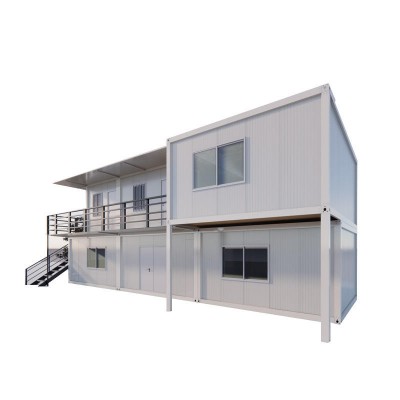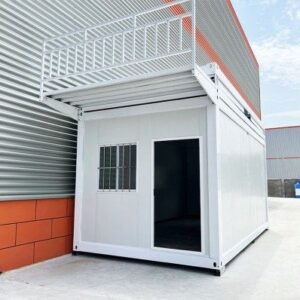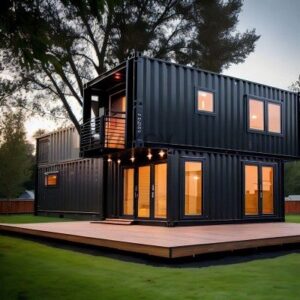Assessing Your Needs Size and Design Preferences
Before you start building, figure out what you need from your container home. Think about:
- Space requirements: How many bedrooms, bathrooms, and living areas do you want?
- Size and layout: Are you planning a single container or multiple containers combined?
- Design style: Do you prefer a modern look, minimalist space, or something more rustic?
- Future expansion: Will you want to add on later? Plan accordingly.
Knowing this helps you decide how many containers you’ll need and how they can fit on your lot.
Budgeting and Financing Options
Building with shipping containers can save money but setting a clear budget is key. Include costs for:
- Container purchase (new or used)
- Modifications and construction
- Insulation, plumbing, and electrical
- Permits and inspections
- Interior & exterior finishes
As for financing, some banks may be hesitant to fund container homes, so consider:
- Personal savings or loans
- Construction loans from lenders familiar with alternative builds
- Home improvement loans
- Working with companies that offer financing for container projects
Finding and Selecting Quality Containers New vs Used
Choosing between new and used containers depends on your budget and goals:
| Container Type | Pros | Cons |
|---|---|---|
| New Containers | Structurally sound, clean, no hidden damage | More expensive |
| Used Containers | Cheaper, environmentally friendly reuse | Possible rust, dents, unknown damage |
Always inspect containers closely or hire a professional. Look for:
- Structural integrity
- Signs of rust or leaks
- Previous cargo (avoid chemical or hazardous materials containers)
Working with Architects and Designers Experienced in Container Homes
Since container homes have unique challenges, work with experts familiar with this style. They can help you:
- Create efficient, functional floor plans
- Ensure structural safety when cutting/welding
- Choose the best insulation and ventilation systems
- Navigate local building codes and permits
Professional guidance reduces costly mistakes and helps turn your vision into a practical, comfortable home.
Legal Considerations and Permits for Shipping Container Houses
When building a shipping container house, understanding the legal requirements is crucial. Zoning laws and building codes for container homes vary widely depending on your city or county, so you need to check local regulations early in the planning process.
Zoning Laws and Building Codes
- Zoning restrictions might limit where you can place a container home, especially in residential neighborhoods.
- Some areas classify container homes as temporary structures or accessory buildings, which affects what types of permits you need.
- Building codes regulate structural safety, electrical and plumbing systems, and energy efficiency, which your container home must meet.
Approvals and Permits
- Start by visiting your local building department or zoning office to inquire about specific rules for container constructions.
- You’ll likely need permits for:
- Site preparation and foundation work
- Structural modifications like cutting and welding containers
- Electrical and plumbing installations
- Final occupancy approval
- Submit detailed plans and engineering reports showing your home’s design compliance.
Environmental Regulations and Inspections
- Some states require an environmental review, especially if your property is near protected land or wetlands.
- You need to ensure your container home’s insulation, ventilation, and waste management meet environmental and health codes.
- Expect multiple inspections throughout the build—foundation, framing, systems installation, and final walk-through.
By addressing these legal considerations and permits upfront, you avoid costly delays and ensure your shipping container home is safe, compliant, and ready for livable use.
Designing Your Shipping Container Home
When designing your shipping container home, the goal is to balance functionality, comfort, and style within the unique space a container offers. Here’s what to focus on:
Layout and Floor Plans
Start by planning your containers floor layout based on your needs. Whether you’re using a single 20ft container or combining multiple 40ft high cubes, careful planning helps maximize space.
- Consider open floor plans to make small spaces feel larger.
- Zone areas for living, sleeping, and cooking efficiently.
- Use modular design elements to adjust and expand later if needed.
- Check out shipping container house design ideas for inspiration.
Insulation and Climate Control Options
Because steel containers can get hot or cold quickly, proper insulation is crucial:
- Spray foam insulation seals tight gaps and provides strong thermal protection.
- Panel insulation (rigid foam boards) is easier to install and cost-effective.
- Reflective barriers can reduce heat gain in warm climates.
- Don’t forget to insulate ceilings and floors to avoid energy loss.
- Proper insulation improves energy efficiency and comfort year-round.
Ventilation and Natural Light
Steel boxes can trap heat and moisture, so ventilation is key:
- Install windows and vents strategically to promote airflow.
- Skylights or light tubes bring in natural sunlight, reducing electric lighting needs.
- Consider mechanical ventilation if natural airflow is limited.
- Combining ventilation with insulation helps prevent mold and keeps the air fresh.
Structural Reinforcements and Modifications
Modifying containers requires care to keep the structure safe:
- Cutting for doors, windows, or openings must be reinforced with steel beams or frames.
- Welding adds strength where containers join if stacking or joining multiple units.
- Consult professionals experienced in container modifications to avoid weakening the shell.
- Reinforcements ensure your home meets safety codes and lasts longer.
Plumbing and Electrical Integration
Integrating plumbing and electrical systems in steel containers:
- Plan plumbing layouts early since containers have limited wall space; use interior framing to hide pipes.
- Electrical wiring should consider metal walls—use proper conduits and grounding.
- Work with licensed electricians and plumbers familiar with shipping container home construction for a safe setup.
- Integrate energy-efficient lighting and plumbing fixtures to reduce utility costs.
Efficient design combined with the right insulation, ventilation, and system integration can turn a simple container into a cozy, modern home tailored to your lifestyle. For a step-by-step guide on installation and materials, explore how to build a container house.
What is a Shipping Container House
A shipping container house is a unique form of modular housing constructed by converting standard steel freight containers into livable spaces. These containers, originally designed for transporting goods globally, offer a durable, cost-effective foundation for homes. Building a home from shipping containers has gained popularity in the United States due to their affordability, sustainability, and rapid construction potential compared to traditional homes.
Types of Containers Suitable for Housing
When planning to build a shipping container home, choosing the right container type is crucial. The most commonly used containers include:
- 20ft Standard ContainerMeasures approximately 20 feet long, 8 feet wide, and 8.5 feet high. Ideal for single-room spaces or small additions.
- 40ft Standard ContainerMeasuring 40 feet in length, offering more living space while maintaining easy transportability. A popular choice for primary living areas.
- 40ft High Cube ContainerSlightly taller at around 9.5 feet high, providing extra headroom which enhances comfort and allows better insulation options, making it highly suitable for residential builds.
These container types provide flexibility for various home designs, from compact studios to multi-container modular layouts.

Advantages of Shipping Container Houses
- Durability and Strength: Containers are made from Corten steel, designed to withstand harsh weather and heavy loads, making them structurally sound for homes.
- Affordability: Often less expensive than traditional building materials and quicker to construct, lowering labor costs.
- Sustainability: Repurposing containers reduces steel waste and promotes eco-friendly building practices.
- Modular and Scalable: Easily stacked or arranged to create multi-story homes or complex layouts.
- Transportability: Prefabricated container homes can be moved if necessary, adding flexibility.
Disadvantages of Shipping Container Houses
- Insulation Challenges: Steel conducts heat and cold, requiring specialized insulation techniques like spray foam or panel insulation to maintain comfort.
- Permitting and Zoning: Some local jurisdictions have strict regulations around shipping container homes, complicating approvals.
- Space Constraints: Container width limits interior space, sometimes requiring modification or joining multiple containers for livability.
- Corrosion Risk: Without proper treatment, containers can rust, especially in humid or coastal environments.
- Structural Modifications Needed: Cutting for windows, doors, or plumbing can weaken the container, needing expert welding and reinforcement.
Understanding these benefits and limitations upfront ensures you can make informed choices when designing and building your shipping container house.
Construction Process Step-by-Step for Building a Shipping Container House
Building a shipping container house involves a clear sequence of steps, from site preparation to finishing touches. Here’s a simple breakdown of the construction process to help you understand what’s involved:
Preparing the Site and Foundation
Before anything else, you need to get your site ready. This includes clearing the area and choosing the right foundation type based on your budget, soil, and local codes. Common foundation options for container homes include:
- Concrete slab – Solid and stable, best for flat sites.
- Pier foundation – Raised supports ideal for uneven terrain or flood-prone areas.
- Crawl space – Creates space below the home for plumbing and electrical work.
Choosing the right foundation ensures your container home stays level and structurally sound.
Modifying Containers
Once your foundation is set, it’s time to prepare the containers themselves. This step includes:
- Cutting openings for doors, windows, and any additional ventilation.
- Welding and reinforcing structural elements, especially around modified areas to maintain strength.
- Adding support beams if stacking containers or creating multi-level designs.
Professional help is often needed here to make sure cuts and welds are safe and up to code.
Insulating and Waterproofing
Shipping containers are metal boxes, so insulation and waterproofing are key to making them livable. Popular options include:
- Spray foam insulation – Offers excellent air sealing and moisture resistance.
- Panel insulation – Rigid panels installed inside are easy to fit and maintain.
- Waterproof coatings – Applied on exterior surfaces to prevent rust and corrosion.
Good insulation not only keeps the home comfortable but also lowers energy costs.
Installing Windows Doors and Roofing
Next, install windows and doors in the openings you created during modifications. Look for energy-efficient windows with proper sealing to keep drafts out.
For roofing, options include:
- Green roofs with plants for insulation and drainage.
- Metal or shingle roofing added on top of containers to protect from weather.
Proper roofing prevents leaks and improves overall durability.
Interior Framing and Finishing
Inside, you’ll need to frame out walls for rooms and ceilings, which will support:
- Drywall or paneling for walls and ceilings.
- Flooring materials like hardwood, laminate, or tile.
This step turns the metal shell into a comfortable living space that meets your design preferences.
Plumbing and Electrical Installation
Integrate plumbing and electrical systems carefully:
- Run pipes and wiring through framed walls and under floors.
- Connect to local utilities or set up alternative systems like rainwater collection or solar power if off-grid.
Work with licensed professionals to comply with building codes and safety standards.
Exterior Finishing and Painting
Finish by applying exterior treatments such as:
- Rust-resistant paint for durability and aesthetics.
- Cladding with wood, vinyl, or composite materials for extra insulation and style.
This final layer protects your investment and gives the home a polished look.
By following these clear steps, your shipping container home will be structurally safe, energy-efficient, and ready to live in. Keep in mind, each step may require specific permits or inspections depending on your location—planning ahead saves headaches later.
Common Challenges in Shipping Container Homes and How to Overcome Them
Building a shipping container house comes with its unique set of challenges. Knowing how to handle these issues upfront can save time, money, and stress. Here are the main challenges you’ll face and practical ways to tackle them.
Dealing with Rust and Corrosion
Rust is a top concern since containers are made of steel exposed to harsh conditions before use. If not treated properly, rust can weaken the structure and shorten your home’s lifespan.
- Choose containers with low rust damage or ones that have been professionally sandblasted.
- Apply rust-inhibiting primers immediately during construction.
- Use high-quality protective paint designed for metal surfaces.
- Regularly inspect and maintain painted surfaces to prevent new corrosion.
Structural Challenges with Stacking and Modifying Containers
Stacking containers or cutting openings for windows and doors affects strength and stability.
- Work with an architect or engineer experienced in modular container housing to plan reinforcements.
- Reinforce cut areas with steel welds or frames to maintain integrity.
- Consider extra welding or adding steel posts when stacking containers more than two stories tall.
- Avoid over-modifying containers; too many cuts can compromise structure and safety.
Moisture and Mold Prevention in Container Homes
Containers can trap moisture easily without proper insulation and ventilation — which leads to mold and poor indoor air quality.
- Use high-quality spray foam insulation or rigid panels that act as both insulator and vapor barrier.
- Design your home with good ventilation systems and strategically placed windows for natural airflow.
- Install proper drainage around your foundation to keep moisture away from the container base.
- Keep gutters and exterior finishes in good condition to prevent water seepage.
Budgeting for Unexpected Costs
Building with shipping containers often involves surprises that can push your budget higher.
- Set aside an extra 10-20% contingency fund for unforeseen issues like container repairs, custom fabrication, or unexpected materials.
- Factor in costs for permits, site preparation, and professional services that might not be obvious at first.
- Get multiple quotes from contractors and suppliers to avoid sticker shock.
- Consider DIY on simpler tasks like interior finishing to stretch your budget.
By understanding these common challenges and having a clear plan to manage them, you can make your shipping container home experience smoother and more cost-effective.
Cost Breakdown and Timeline for Building a Shipping Container House
When it comes to building a shipping container house, understanding the average costs and timeline helps you plan smarter and avoid surprises. Costs vary depending on container type, size, location, and finishes, but here’s a practical overview to guide your budget and schedule.
Average Costs of Materials and Labor
- Containers
- New 20ft or 40ft containers: $3,000–$5,000 each
- Used containers: $1,500–$3,000 each (ensure good condition)
- Modifications and Fabrication
- Cutting, welding, and structural reinforcements: $10,000–$30,000 depending on complexity
- Insulation and Weatherproofing
- Spray foam or panel insulation typically costs $5,000–$15,000
- Windows, Doors, Roofing
- $8,000–$20,000 depending on materials and number of openings
- Interior Finishing
- Drywall, flooring, framing: $15,000–$40,000
- Plumbing and Electrical Systems
- Installation generally costs between $10,000–$25,000
- Foundation and Site Preparation
- Slab, pier, or crawl space foundations vary widely but expect $5,000–$15,000
Total average cost: $50,000 to $150,000+ depending on size, design, and location.
Cost-Saving Tips for Your Container Home
- Opt for used containers but inspect thoroughly for rust or damage.
- Limit container modifications to reduce fabrication labor.
- Choose energy-efficient insulation materials to lower long-term utility bills.
- Plan a simple floor plan to minimize structural changes.
- Do some interior finishing or plumbing work yourself if qualified.
- Purchase materials locally to reduce shipping fees.
Typical Timeline from Planning to Move-in
| Phase | Duration (Weeks) |
|---|---|
| Initial Planning and Design | 2 to 6 |
| Permits and Approvals | 4 to 12 (varies by county/state) |
| Container Purchase & Delivery | 1 to 4 |
| Site Preparation & Foundation | 1 to 3 |
| Container Modification | 4 to 8 |
| Insulation & Weatherproofing | 1 to 3 |
| Interior Finishing | 4 to 10 |
| Plumbing and Electrical | 2 to 4 |
| Final Inspection and Move-in | 1 to 2 |
Total project duration typically ranges from 3 to 6 months, but this depends heavily on your local building codes, contractor availability, and design complexity.
Understanding these costs and timeline realities helps streamline your shipping container home building process so you can enjoy your sustainable, customizable living space without unexpected headaches. For more detailed container options and guidance, explore small container house choices or check out our full construction guide.
Case Studies of Shipping Container Houses Real-Life Examples and Lessons Learned
Looking at real-life shipping container houses can give you a clear idea of what to expect and help avoid common pitfalls. Here are a few examples from across the US that showcase the possibilities and challenges of container home building.
Local Container Home Example 1: Compact 20-Foot Container House in Texas
A family in Texas built a 20-foot shipping container home as their primary residence. They chose a single container design for simplicity and cost savings.
Key takeaways:
- Used spray foam insulation to handle the Texas heat, which worked well.
- Customized windows and doors for better airflow and natural light.
- Encountered some rust issues that required extra waterproofing early on.
- Kept electrical and plumbing installations straightforward to reduce costs.
You can explore similar models like the 20ft single container house for ideas on simple yet efficient designs.
Example 2: Expandable 40-Foot Container Home in California
This California project involved combining two 40-foot high cube containers, creating an expandable living space with solar panels for energy efficiency.
Lessons learned here:
- High cube containers give more headroom and comfort.
- Environmental regulations required thorough permitting and inspections — early engagement with local authorities helped.
- Modular design allowed for future expansion.
- Integration of plumbing and electrical systems upfront minimized costly adjustments later.
Check out expandable container houses for ideas on flexible, green designs.
Example 3: DIY Container Home in Oregon
A DIY enthusiast in Oregon converted a used container into a cozy off-grid cabin.
Highlights and challenges:
- Used panel insulation with additional vapor barriers to prevent moisture damage, a common challenge in wet climates.
- Faced some unexpected structural modifications, emphasizing the need for proper planning.
- Budgeting tightly helped them make smart decisions; however, unplanned expenses still appeared.
- This project proved how DIY can be rewarding but requires careful knowledge of cutting, welding, and waterproofing.
What These Examples Teach Us
- Planning matters: From size and design to legal permits, plan in detail early on.
- Insulation and climate control: Tailor your insulation to local climate for comfort and energy savings.
- Quality containers: Choosing between new and used affects long-term maintenance, especially rust prevention.
- Permits and codes: Always check local laws to avoid fines or reworks.
- Budget for surprises: Unforeseen costs happen—build a buffer in your budget.
For more info on costs and building processes, check out our detailed guides like the cost of building a shipping container house.
Real-world projects show that shipping container home construction can be practical and eco-friendly, but success depends on thoughtful design, quality materials, and thorough preparation



